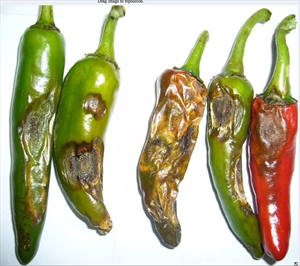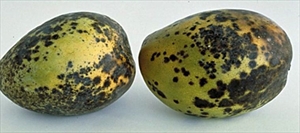Capsicum anthracnose
Pacific Pests, Pathogens, Weeds & Pesticides - Online edition
Pacific Pests, Pathogens, Weeds & Pesticides
Capsicum (chilli) anthracnose (177)
Colletotrichum species, most often Colletotrichum acutatum, Colletotrichum capsici (possibly the same as Colletotrichum dematium) and Colletotrichum gloeosporioides (the sexual state is Glomerella cingulata).
The fungi are likely to be present in all Pacific island countries where capsicum and chillies are grown; they are common fungi. Colletotrichum gloeosporioides occurs in American Samoa, Australia, Cook Islands, Federated States of Micronesia, Fiji, Kiribati, Marshall Islands, New Caledonia, Niue, Palau, Papua New Guinea, Samoa, Solomon Islands, Tonga, Tuvalu, and Vanuatu (and more); Colletotrichum capsici in Cook Islands, Fiji, Niue, Papua New Guinea, Samoa, Solomon Islands, and Tonga; Colletotrichum acutatum in Fiji and Samoa.
Capsicum and chilli, and other kinds of vegetables (e.g., tomato), root crops (e.g. yam), and fruit trees (e.g., papaya, mango).
On the fruits of chilli and capsicum, the first sign of the disease are small, slightly sunken, dark yellow spots on the fruit surface. The spots darken, enlarge and merge during wet weather or when humidity is high (Photos 1&2). Often, there are multiple infections on the one fruit (Photos 3&4). Pink spore masses of fungal spores form on the spots, arranged in rings (Photos 5-7) and, later, these turn black as dark hairs develop (Photo 6).
Post-harvest rots are also common (e.g., avocado, eggplant and mango) (Photos 8-11).
On the leaves, irregularly shaped brown spots with dark borders. These spots are similar to frog-eye spot (see Fact Sheet no. 92). However, symptoms on leaves are often rare, even in fields with severe fruit infection.
Infection can occur at any stage of fruit development, but symptoms usually appear on the fruit when they are about to ripen. There are, however, more aggressive species, such as Colletotrichum acutatum, that cause symptoms at any stage of fruit development. Warm wet weather, with temperatures around 27°C, and humidity above 80%, are ideal for disease development. Leaf wetness is a particularly important factor.
Spread of the fungi over short distances is by spores in wind-driven rain. Fruit can also become infected from the fungi living on debris in the soil. Survival occurs in crop debris and on or in capsicum seed. It is likely that survival also occurs on weeds and other crops species; these fungi have a wide host range.
Anthracnose of capsicum and chillies can be a serious problem in tropical and subtropical regions. The damage caused by anthracnose is especially serious in many Asian counties including South Korea, Taiwan, Indonesia and Thailand, reducing marketable yields by 10-80%. In these countries, Colletotrichum acutatum is the most destructive of the several anthracnose pathogens present.
The fungi causing anthracnose can be on or in the seed, and this can lead to pre- and post-emergence damping off.
Look for spots on the fruit, first yellowish, rapidly growing, merging, turning pink as the spores develop and later black with concentric rings. Look for irregularly shaped brown spots on the leaves with dark brown borders.
CULTURAL CONTROL
Before planting:
- Use disease-free seed. Seed should be treated at 52°C for 30 minutes. But do not guess; use a thermometer and accurately time the treatment.
- Check each seedling for freedom from leaf spots before taking the seedlings from the nursery to the field.
During growth:
- Avoid overhead irrigation as water splash spreads these fungi, or if overhead irrigation is used, apply early in the day so that the plants are dry before evening.
- Control weeds and volunteer capsicum and chilli plants.
After harvest:
- Do not plant capsicum in the same land if the last crop was diseased; leave a gap of 3 years and during the period of rotation avoid crops in the capsicum family, for instance, tomato or eggplant.
- Plough in or remove crop residues in infected fields.
RESISTANT VARIETIES
AVRDC, The World Vegetable Center, and other research institutions have been breeding chilli peppers for resistance to anthracnose. However, the resistant lines need to be evaluated on site to confirm their performance against the species (and strains) present at different locations.
CHEMICAL CONTROL
If a fungicide is needed, use mancozeb or a copper product. Apply protective sprays beginning at flowering.
____________________
When using a pesticide, always wear protective clothing and follow the instructions on the product label, such as dosage, timing of application, and pre-harvest interval. Recommendations will vary with the crop and system of cultivation. Expert advice on the most appropriate pesticides to use should always be sought from local agricultural authorities.
AUTHORS Zhong-Ming Sheu, Jaw-Fen Wang & Grahame Jackson
Information from Diseases of fruit crops in Australia (2009). Editors, Tony Cooke, et al. CSIRO Publishing; and from Eric McKenzie (2013) Colletotrichum acutatum (Photo 8), Colletotrichum capsici (Photos 9&10) and Colletotrichum gloeosporioides (Photo 11): PaDIL - (http://www.padil.gov.au). Photos 1&2 Mani Mua, SPC, Sigatoka Research Station, Fiji. Photos 3-5 AVRDC, The World Vegetable Centre. Photos 6 Than PP, et al. (2008) Chilli anthracnose disease caused by Colletotrichum species. J Zhejiang Univ Sci B. 9(10): 764Ð778. Photo 8 Colletotrichum acutatum, Photos 9&10 Colletotrichum capsici,
Produced with support from the Australian Centre for International Agricultural Research under project PC/2010/090: Strengthening integrated crop management research in the Pacific Islands in support of sustainable intensification of high-value crop production, implemented by the University of Queensland and the Secretariat of the Pacific Community.














